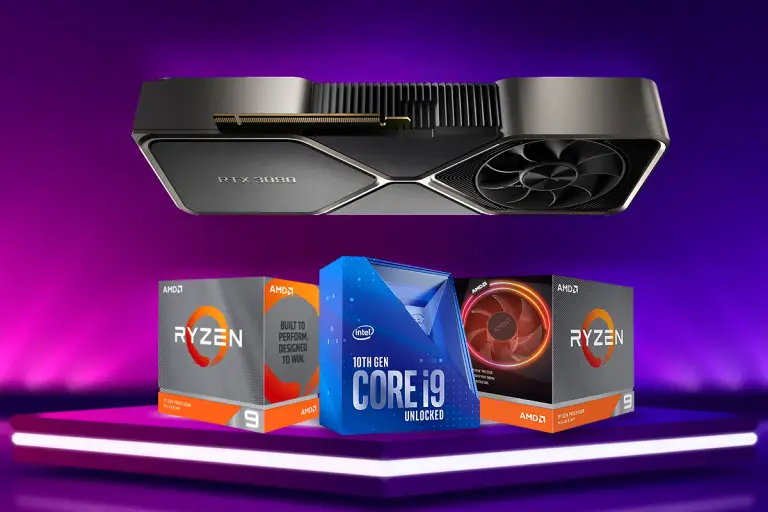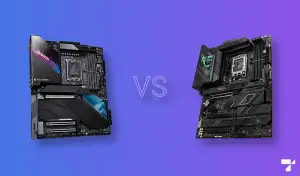Nvidia’s RTX 3000 series GPUs have provided a substantial performance increase with the implementation of their cutting-edge Ampere technology. This performance leap is so great that what is still one of the best graphics cards in the world, the RTX 2080 TI, is now outgunned by some of these RTX 3000 series GPUs. More specifically, the RTX 3080 is about 50% faster than its 2080 counterpart. But with that much graphical power, an equally fantastic CPU is needed. Therefore, we have reviewed the best CPUs for RTX 3080.
The Geforce RTX 3080 is getting most of the attention because it brings a massive boost to any 4K gaming system at a considerably lower price. With 8,704 CUDA cores, 10GB of GDDR6 memory, and a throughput of 30 TFLOPS, this graphics card has a lot to offer for Nvidia’s launch price of $699. In addition, the architecture also supports PCIe 4.0, and it includes a new technology called RTX I/O, which is going to boost loading speeds.
But to benefit from some of these improvements we need to make sure the CPU is up to the task. And on a side note, you might want to take a look at your computer’s power supply because the RTX 3080 has a higher power consumption (320W) than the previous generation.
Best Processors for RTX 3080
Having a good CPU is important and everyone who wants to utilize the full potential of the RTX 3080 is probably asking themselves the age-old question: Intel or AMD? This is relative and it depends on each individual’s requirements, plans, and budget. With that in mind, it’s recommended to have at least a six-core Intel or AMD Ryzen CPU. So let’s go through the best CPUs for an RTX 3080 build and learn what makes them so great.
1. AMD Ryzen 9 5900X
Specifications
Architecture: Zen 3 | Socket: AM4 | Cores/Threads: 12 / 24 | Base Frequency: 3.7GHz | Boost Frequency: 4.8GHz | TDP: 105WKey Features
- PCIe 4.0 support
- 7nm architecture
- 70MB total cache
- AMD StoreMI technology
- AMD Ryzen Master Utility
The Ryzen 9 5900X is one of the best mainstream high-end processors out there. With 12 cores / 24 threads and 4.8GHz boosted frequency, this CPU is a perfect match with the RTX 3080. If you’re looking for the best 4K gaming experience, as well as a machine capable of handling demanding software, the 5900X is worth the investment. Professional applications benefit greatly from a high multi-threaded performance, and if you have adequate cooling, you can push the 5900X quite far. Additionally, it doesn’t require much power, having a TDP of only 105W.
When it comes to features, the 5900X is future-proof. It supports the PCIe 4.0 interface, and it boosts the data transfer rates thanks to the included StoreMI technology from AMD. The 5900X combined with the RTX 3080 will make loading screens a thing of the past once games and programs start taking full advantage of the new PCIe 4.0 support.
That being said, this next-gen Ryzen 9 is best used by enthusiasts who want a top-of-the-line PC that will stay relevant for years. And if you’re a serious gamer, you won’t have to worry about upgrading for a while because we live in times when the game developers have to catch up with the hardware instead of the other way around.
2. AMD Ryzen 9 5950X
Specifications
Architecture: Zen 3 | Socket: AM4 | Cores/Threads: 16 / 32 | Base Frequency: 3.4GHz | Boost Frequency: 4.9GHz | TDP: 105WKey Features
- PCIe 4.0 support
- 7nm architecture
- 72MB total cache
- AMD StoreMI technology
- AMD Ryzen Master Utility
AMD has taken control of the CPU market, at least for now, with the Ryzen 9 5950X as the flagship. This 16-core / 32-thread processor outshines most processors in the consumer range. With a lower 3.4GHz base frequency but an impressive 4.9GHz boost frequency, this CPU will turn almost anything into a computational monster. AMD proves their 7nm architecture is superior and continues to fully unlock their CPUs for overclocking. In fact, the 4.9GHz boost speed isn’t the true limit. Some enthusiasts have pushed the 5950X beyond that by using high-end cooling systems, demonstrating that heat is what truly limits this beast. So if you’re looking to extract every bit of performance out of this Zen 3 CPU, make sure you invest in an adequate cooling system and a solid power source.
That being said, the 5950X is a powerhouse for multi-threaded performance. It excels when used with demanding creative and professional software. When combined with the RTX 3080, it turns into a powerful system for 3D modelers and for rendering. As for gaming, it’s just as good, and no game will ever bring it even close to the full processing load. In fact, if you’re interested only in gaming, the 5950X is overkill and you should probably invest in a 5800X or 5900X instead.
All in all, the Ryzen 9 5950X is one of the most powerful processors out there and you can’t go wrong when matching it with the RTX 3080, as long as your budget is generous enough.
3. Intel i9-10900K
Specifications
Architecture: Comet Lake-S | Socket: LGA 1200 | Cores/Threads: 10 / 20 | Base Frequency: 3.7GHz | Top Boost Frequency: 5.30GHz | TDP: 125WKey Features
- 10 cores at a reasonable price
- Thermal Velocity Boost allowing a 4.9GHz boost to all cores and 5.3GHz for one core
- New overclocking controls
- Hyper-Threading technology
Intel impressed the market with this processor’s top speed of 5.3GHz that can’t be easily matched. This is possible in bursts on top of the regular Turbo Boost using Intel’s new Thermal Velocity Boost that we encountered earlier on the I9-9900K as we. But what’s even more impressive is having a multi-core boost of 4.9GHz out of the box. Combined with the fact that it has ten cores, this processor is definitely a great match with the RTX 3080. However, such high clock speeds result in a high energy requirement, which in turn results in a lot of heat. A high-quality cooler is needed to keep everything under control.
While the 10900K is a well-performing beast, there are a couple of downsides that need to be considered. It doesn’t support the latest PCIe 4.0 and even if the motherboard does, it doesn’t matter. This aspect is especially important because the new generation of consoles will support PCIe 4.0 and game developers are pushing to squeeze game performance out of fast SSDs. Furthermore, you’re going to need a Z490 motherboard for the LGA 1200 socket. So even if you have a Z390 that came out in late 2018, it’s already unusable with this processor.
Intel’s i9-10900K is a good option if you already have the right system for it and if you find a good deal. It offers great performance, but the disadvantages may outweigh the benefits, especially when considering that the next generation of Ryzen processors is around the corner.
4. AMD Ryzen 7 5800X
Specifications
Architecture: Zen 3 | Socket: AM4 | Cores/Threads: 8 / 16 | Base Frequency: 3.8GHz | Boost Frequency: 4.7GHz | TDP: 105WKey Features
- PCIe 4.0 support
- 7nm architecture
- 36MB total cache
- AMD StoreMI technology
- AMD Ryzen Master Utility
The Ryzen 7 5800X is probably the most exciting addition to the new Zen 3 line of processors from AMD. This 8 core/16 thread CPU has the most performance per dollar to offer to those of us who are building a new gaming system. The 7nm architecture combined with 4.7GHz clock speed, and a sizable 36MB cache makes high-end gaming on a budget possible. And when combined with an RTX 3080 we get a future-proof PC that we can enjoy for years to come.
The 5800X is the middle child in the 5000 series of Zen 3 CPUs, but it will not hold your system back or bottleneck the RTX 3080 in any way. For gaming, it’s more than enough, especially since most games rarely take advantage of any CPU that has more than six cores. This is especially true with the new line of processors that has an architectural advantage over the old generations, as well as a series of features that will become important in the near future.
That being said, the 5800X supports the PCIe 4.0 interface, which is also supported by the RTX 3080. This feature will significantly reduce loading times and data transfers as games start being adapted with it in mind. Additionally, if you plan to overclock your CPU, the 5800X comes with AMD’s Ryzen Master Utility software that makes overclocking a breeze.
All in all, the Ryzen 7 5800X is the most optimal processor for gaming without breaking the bank. But if you want something that works faster with demanding software, you should look for a processor with a higher thread count, such as the 5900X or even 5950X.
5. AMD Ryzen 9 3900X
Specifications
Architecture: Zen 2 | Socket: AM4 | Cores/Threads: 12 / 24 | Base Frequency: 3.8GHz | Top Boost Frequency: 4.6GHz | TDP: 105WKey Features
- PCIe 4.0 for better graphics and storage bandwidth
- 7nm technology
- 70MB GameCache memory for boosted performance
- Wraith Prism Cooler with Razer Chroma support included
This processor offers high performance at a fairly low price when compared to other alternatives. It has 12 cores and 24 threads, but its price point is competing with Intel’s I9-9900K, which is an 8-core processor with 16 threads. The Ryzen 9 3900K is without a doubt contributing to the Intel vs. AMD competition, but counting cores and threads isn’t quite enough to determine the best option. Single-core performance matters as well since so many games fail to take full advantage of multiple cores.
With the third generation of Ryzens and the Zen 2 architecture, we see 7nm processors entering the affordable mainstream market. According to AMD, they succeeded in boosting the count of instructions per clock (IPC) by a maximum of 15%. Together with a core boost of up to 4.6GHz, this Ryzen 9 becomes highly competitive in the single-core performance field as well. Furthermore, the smaller 7nm node resulted in significantly higher cache size, as well as higher power efficiency. Take note that AMD started referring to the L2 and L3 cache together as “GameCache”. So we have a combination of 64MB of L3 and 6MB of L2 giving us a total 70MB cache. This is an important aspect because it provides our systems with a boost in performance, especially when running games in 1080p.
Another special feature is the inclusion of PCIe 4.0 that the RTX 3080 uses as well. As a result, higher reading speeds will be noticed. This also includes a noticeable boost to SSDs.
All in all, the Ryzen 9 3900X is one of the best choices when combined with an RTX 3080. The two components go hand in hand without bottlenecking each other and without ripping through your pockets.
6. AMD Ryzen 9 3950X
Specifications
Architecture: Zen 2 | Socket: AM4 | Cores/Threads: 16 / 32 | Base Frequency: 3.5 GHz | Top Boost Frequency: 4.70 GHz | TDP: 105WKey Features
- 16 cores for the mainstream market
- PCIe 4.0 for better graphics and storage bandwidth
- 7nm technology
- 72MB GameCache memory for boosted performance
For the first time we get experience using a 16-core processor and we don’t even have to rob a bank for it. Like it’s brother 3900X, its 7nm build offers us more performance, power efficiency, and a higher core count in a small package.
AMD implemented the PCIe 4.0 interface with this processor as well, boosting the throughput of SSDs, while also sticking to their standard AM4 socket. Essentially, we’re looking at an improved 3900X that works the same, but comes with four additional cores and can be overclocked for another 100MHz.
The only serious challenge with this processor is having enough cooling to handle the extra four active cores. According to AMD, we should be using a solid 280mm AIO cooler at a minimum. So if you choose to boost your RTX 3080 with the Ryzen 9 3950X, make sure you don’t skimp on the cooling, otherwise, you won’t manage to extract every ounce of performance.
7. Intel Core I7-10700K
Specifications
Architecture: Comet Lake | Socket: LGA 1200 | Cores/Threads: 8 / 16 | Base Frequency: 3.8 GHz | Top Boost Frequency: 5.10 GHz | TDP: 125WKey Features
- Overclockable up to 5.1 GHz using Turbo Boost Max 3.0
- Hyper-Threading technology
- New overclocking controls for more efficient tuning
- Intel Optane Memory support
This tenth generation i7 is in fact similar to the i9-9900K because both of them have the same amount of cores and threads, but the i7 is significantly cheaper. This alone brings the i7-10700K to the best CPUs list for any RTX 3080 build.
This CPU has a fairly high 3.8 GHz base clock that makes it especially competitive when it comes to single-threaded power. Intel also included the Turbo Boost Max 3.0 technology for the first time in the i7 lineup, bringing this processor close to the performance achieved by the i9-10900K, especially when fully overclocked. However, the Thermal Velocity Boost feature is only included with the i9, but the difference is barely noticeable in most games and applications. The i7 is a powerful rival for AMD’s Ryzen line and it’s surprisingly efficient when it comes to heat generation. While you won’t be able to keep it under control with a basic cooler, it doesn’t require anything overly expensive either. A standard water-based cooler or a 240mm air cooler is enough to unlock its full performance.
The i7-10700K is overall a good option for high-end gaming setups without breaking the bank for an i9 that would in addition require an equally high-end cooling system. This processor is a step up from the previous generation mainly because it has a lower price per thread. However, keep in mind that it doesn’t offer the next-gen PCIe 4.0 interface, only PCIe-3.0.
8. AMD Ryzen 5 5600X
Specifications
Architecture: Zen 3 | Socket: AM4 | Cores/Threads: 6 / 12 | Base Frequency: 3.7GHz | Boost Frequency: 4.6GHz | TDP: 65WKey Features
- PCIe 4.0 support
- 7nm architecture
- 35MB total cache
- Wraith Prism Cooler with Razer Chroma support included
- AMD Ryzen Master Utility
- AMD StoreMI technology
The Ryzen 5 5600X is the most budget-friendly CPU from the new Zen 3 lineup. This little beast is excellent for gaming, especially when paired with the RTX 3080 because for most games you don’t need anything beyond 6 cores / 12 threads. So as long as the 5600X doesn’t bottleneck the RTX 3080, and it doesn’t, it remains a solid choice even for gaming at 4K resolutions.
On a side note, while the 5600X is certainly a great CPU, it doesn’t bring that much extra performance when compared to its predecessor, the 3600X, but it costs more. So if you’re heavily restricted by your budget, you should also consider the second-generation Ryzen 5 because it’s nearly as capable. Besides, both of them are built using the same 7nm manufacturing process and they support PCIe 4.0. So the 3600X is just as future-proof.
That being said, the 5600X won’t hold you back and is still very affordable. It also has a very low power requirement, so if you’re also somewhat restricted by your PSU or you simply don’t want to replace it just yet, this processor is a great option. In addition, the 5600X is the only processor in the Zen 3 lineup that comes with a cooler included. So again, if your budget is tight, you’ll also save some money by not having to purchase a separate cooling system. However, if you plan on overclocking the CPU, the stock cooler won’t be enough.
In essence, the Ryzen 5 5600X is a solid choice for mainstream gaming builds as it works hand in hand with the RTX 3080.
9. AMD Ryzen 7 3800X
Specifications
Architecture: Zen 2 | Socket: AM4 | Cores/Threads: 8 / 16 | Base Frequency: 3.9 GHz | Top Boost Frequency: 4.50 GHz | TDP: 105WKey Features
- PCIe 4.0 for better graphics and storage bandwidth
- 7nm technology
- 36MB GameCache memory for boosted performance
- Wraith Prism Cooler with Razer Chroma support included
The 3000X series is overall a great choice for a modern computer system focused around the RTX 3080. At a first glance, the 3800X version, in particular, seems to be in a sweet spot when it comes to single-threaded and multi-threaded performance. The difference between base and boost frequency is also smaller, something that might please those who don’t like to overclock their CPU.
As we look further under the hood, we see that the 3800X also supports PCIe 4.0. This feature is an asset when it comes to future-proofing, but it also means we need a somewhat expensive motherboard. However, this CPU is more affordable than the 3900X so investing in an X570 might be less of an issue. In fact, this Ryzen 7 variant can match the 3900X’s performance in some applications and games when overclocked so the performance/value ratio makes it a good deal.
This CPU is constructed using the same Zen 2 architecture and 7nm process, just like its superior variants, making it a powerful yet affordable option. Furthermore, it’s compatible with most motherboards that come with an AM4 socket, so you can still install it even if you don’t have a PCIe 4.0 capable system right now. The 3800X also comes with 32MB of L3 cache, or a combined cache of 36MB.
It’s also worth mentioning that this processor is a boosted version of the 3700X version, which has the same amount of cores/threads and cache, but it has a higher base frequency of 300MHz. The difference is smaller when comparing their boost frequencies where the 3800X overtakes its smaller sibling by 100MHz. So if you plan on overclocking your CPU anyway, you might want to take a look at the 3700X version and save some money.
Finally, AMD included their capable Wraith Prism cooler with the 3800X, which should be up to the task at base frequencies. However, when pushing the CPU to the max it will probably not be enough and you’ll need to purchase a more powerful cooling system.
10. AMD Ryzen 7 3700X
Specifications
Architecture: Zen 2 | Socket: AM4 | Cores/Threads: 8 / 16 | Base Frequency: 3.6 GHz | Top Boost Frequency: 4.40 GHz | TDP: 65WKey Features
- PCIe 4.0 for better graphics and storage bandwidth
- 7nm technology
- 36MB GameCache memory for boosted performance
- Wraith Prism Cooler with Razer Chroma support included
The 3700X is marketed towards the mainstream consumer due to its great price to performance ratio. Thanks to its 8 cores, 16 threads, and 7nm process, we have a powerful yet affordable processor. It’s quite similar to the 3800X when it comes to performance, but it consumes less power. Most of the other Ryzen CPUs require 105W and their Intel equivalent needs 125W. The fact that the 3700X model needs only 65W means we can keep the budget down when purchasing a strong enough power supply for the RTX 3080 and we might even get away with a 650W PSU if we don’t overclock. Furthermore, we don’t need a top-shelf cooler to keep everything under control.
What’s even more amazing about this CPU is that the PCI 4.0 interface is implemented just like with the top tier models. This makes the 3700X truly shine as SSDs are going to operate much faster than with the PCIe 3.0 processors.
All in all, the Ryzen 7 3700X has smaller power requirements, but still manages to offer enough performance for 4K gaming. Together with the next-gen PCIe 4.0 interface, it becomes a worthy companion for the RTX 3080 and it’s going to maintain its relevance in the future, especially to those who are more concerned about their budget.
Final Thoughts
The intense rivalry between Intel and AMD provides us with more amazing options at better prices than ever before. Whether you’re a competitive gamer looking for the best hardware, or an enthusiast, there’s a CPU for everyone. So choose the Ryzen 7 3700X, the Intel i9 10900K, or any other option from this list and you’ll be able to unlock the RTX 3080’s full potential and immerse yourself in your favorite game world. You can also learn more about how to choose the best CPU here.



